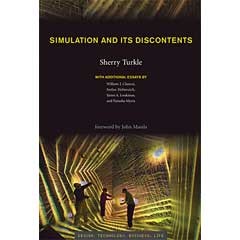
Daily life is being reshaped so rapidly and extensively by quickly pervasive new technologies that experienced perspective is correspondingly crucial. With The Second Self in 1984, Sherry Turkle established herself as a trenchant observer and analyst of the personal computer's effects on people, and perhaps more importantly, as a deft writer on the subject. In this new book, she examines how professionals in several fields interact with computer simulation, suggesting the effects on all our lives. For as we've seen with cell phones and related applications, evaluating their effects is an afterthought at best. "The more powerful our tools become," she writes, "the harder it is to imagine the world without them."
As a new faculty member at MIT in the 1980s, Turkle surveyed student and faculty reactions to the increasing use of computers in academic and professional settings. Twenty years later (finishing in 2005), she went back to the architects, engineers, chemists and physicists in the same firms and departments. In this book, she presents findings from both studies, highlighting their contrasts but also the developing themes.
The central theme is the most obvious and most profound: the worry over losing a sense of reality while being seduced by simulations. Simulations hide their own errors. The first simulations of crystals growing were mesmerizing, and also wrong. Simulations express biases in their code, their structure: an early computer game called Sim City (players planned and built a city) embedded economic theories associated with Milton Friedman, so that taxes for social purposes were always bad.
In the 1980s, Turkle found faculty insisting that students learn the programming to understand the assumptions of the simulations they used. By 2005, few were doing so. A generation has grown up with computer simulations, and the fear is that they can no longer detect errors because they have little experience with the reality being simulated. (Interestingly, Turkle found cases in which older faculty were pushing simulation programs but being resisted by younger students, who wanted more hands-on experience.)
Architects find that simulated designs look so "finished" that it's hard to change them, even though they are preliminary. Builders weren't checking computer designs, assuming they were correct. But the basic fact of programming still pertains: garbage in, garbage out. Computers can be wrong, based on wrong assumptions and biases, and following programming steps that don't end up reflecting reality.
Turkle's study is 100 pages of this book. The rest is comprised of case studies, including two that are especially fascinating: William Clancey's study of NASA scientists and their relationships to the Mars rovers, and Stefan Helmreich's description of high tech deep ocean explorers, about to be made obsolete by technology that doesn't require human presence.
Comments